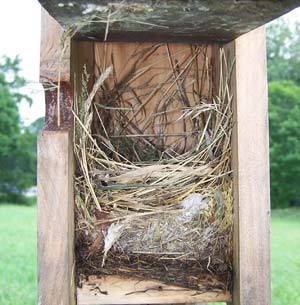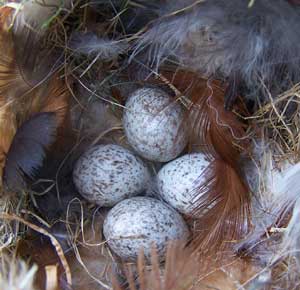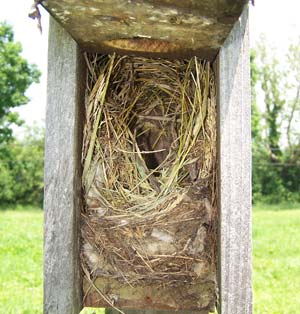Here are four bluebird boxes in perfect bluebird habitat – open, mowed grassland. Every one was being used by House Sparrows (HOSP). One was a slot box, the others were standard NABS boxes. 
Although some people find that slot boxes (shown in the photo to the left) are HOSP-resistant, this HOSP clearly didn’t know that was the case. Shallower slot boxes may be less preferred by HOSP, but also offer easier access to predators. Another problem with wooden slot boxes is warping roofs, which can change the size of the entrance. See pros and cons of various nestbox styles.
In reality, any nestbox suitable for bluebirds can be entered by a HOSP. Even if they do not prefer a certain box style, if nothing else is available, HOSP may still use it. See HOSP Management – Nestbox Style.
The boxes are all mounted on wooden posts, affording easy access to predators. See drawings of effective predator guards.
This trail is very visible to passers by. Although the boxes are well-made, they are sending the wrong messages about how to mount nestboxes, controlling non-native House Sparrows, and how to maintain a trail.

This HOSP nest demonstrates the use of seed heads, which are generally not present in bluebird nests. It also shows typical HOSP construction with nesting material curving up the sides of the box. See descriptions of nests and photo album. Also see HOSP photos.
In addition, you can see several layers of nests, indicating the box is probably not cleaned out after each nesting. See monitoring guidelines.
I am going to contact the trail owner to see if they will let me help out. See template of a letter that can be sent to owners of neglected nestboxes that are breeding HOSP.

HOSP nests are typically bulky, and contain feathers and trash.
It’s always depressing to see blue feathers incorporated into a HOSP nest. HOSP will even build their nests on top of their victims’ corpse. See descriptions and photos (warning – graphic) of HOSP attacks.

Notice trash (cellophane) and overall bulkiness of nest.
As late as 8/11/06, one of these boxes still had an active House Sparrow nest in it with four eggs. This is one reason why HOSP are such effective invaders – their nesting season starts earlier and ends later than most  other cavity nesters. They may have 2-4 broods per season.
other cavity nesters. They may have 2-4 broods per season.

This photo also shows several layers of nests, again indicating lack of trail maintenance.
In addition, the HOSP nest has a tunnel entrance generally found in nests made out in the open air. HOSP nests in nestboxes often lack the tunnel entrance.
What a waste of nestboxes and open space.
Previous Pictures of the Week: © Original photographs are copyrighted, and may not be used without the permission of the photographer. Please honor their copyright protection. If you would like to use a photo for educational purposes, you can contact me.
- Tips for photographing cavity nesters
- June 11, 2006 – Great Crested Flycatcher
- June 19, 2006 – Snake Lick
- June 26, 2006 – House Finch Nest
- July 3, 2006 – Tree Swallow in Flight
- July 17, 2006 – Bluebird Battle
- July 24, 2006 – Bear Attack
- August 1, 2006 – Neglected Nestboxes (House Sparrow nests)
- August 14, 2006 – Threesome (Bluebird Babes)
- August 28, 2006 – Peering (flicker)
- January 2007 – New Hill Trail (Sialis)
- February 12 2007 – Sharp-shinned? Hawk feeding on dead starling
- February 19, 2007 – Joe’s Cafe (Suet/Mealworm Feeder)
- March 25, 2007 – Sunflower Eater
- February 2007 – Snags & Suet (Pileated Woodpeckers)
- May 2007 – Birdcam Shots and Birdcam Photo Album
- May 12, 2007 – Carolina Wren nest in a boot
- May 25, 2007 – Batman Bird (Tree Swallows)
- June 2007 – Bluebird nest of cattails, one with leaves, and a TRES nest with maple seeds
- June 20, 2007 – Nine Egger (Tree Swallow nest)
- June 27, 2007 – Black-capped Chickadees (funny and serious photos)
- July 7, 2007 – Anting and Sunbathing
- Red-shouldered Hawk perching on nestbox
- November 18, 2007 – Western Bluebirds at the Spa
- March 15, 2008 – Under Construction – Eastern Bluebirds Building a Nest
- April 9, 2008 – Bluebird Battle in PA
- April 10, 2008 – Mouse Surprise
- April 15, 2008 – Bluebird News (nest in paper box)
- April 23, 2008 – My personal nightmare
- April 25, 2008 – Brave White-breasted Nuthatch
- April, 2008 – How an egg hatches
- May 3, 2008 – Newborn Blue (baby hatching)
- May 3, 2008 – Brave Blue (female on nest)
- May 14, 2008 – House Wren Havoc (eggs pecked)
- May 25, 2008 – House Wren Takeover (of nest, more pecked eggs)
- May 29, 2008 – Take Your Pick (parents feeding fledgling)
- June 10, 2008 – That Look Belongs in a Holster (female MOBL)
- August 23, 2008 – Cat on Nestbox
- September 28, 2008 – HOSP on the House
- October 10, 2008 – Cuddling nestlings (taken in summer time)
- October 27, 2008 – HOSP in flight
- October, 2008 – Possible double and dwarf egg in one nest
- December 16, 2008 – The Next Generation (children building boxes)
- January 22, 2009 – Blue with Cold
- January 28, 2009 – Prothonotary Warbler on a camper | Nest building PROW | PROW nesting in tree cavity
- May, 2009 – To Kill a Mockingbird (Snake eating mockingbird – may be disturbing)
- May 21, 2009 – Should I Stay or Should I Go Now? (Titmouse nestling in box)
- May 25, 2009 – Which of these is not like the others? (Cowbird egg)
- May 23, 2009 – The Honeypot at the end of the rainbow (bumblebee nest)
- June 20, 2009 – House Wren nest decorated with Western Bluebird feathers
- June 20, 2009 – Wonderful WEBLS of WA
- June 20, 2009 – Bluebirds of Bickleton
- July 12, 2009 – Hairy Shrimp (newborn bluebirds)
- July 2009 – Diet (bluebird with earthworm in beak)
- July 2009 – Bluebirds nesting outside of cavity
- July 19, 2009 – HOSP on Holiday
- July 20, 2009 – Pink bluebird eggs
- August 2, 2009 – Pinkies (baby mice)
- August 2, 2009 – En garde (male bluebird in box)
- September 29, 2009 – 1917 instructions for bird house construction
- I forget when – Rainbox
- April 11, 2010 – nuthatch bark
- April 12, 2010 – My first white egg
- April 12, 2009 – TUTI nest by Keith Kridler
- May 2010 – TUTI newborns
- May 2010 – Christmas Chickadee
- May 2010 – Bluebird and Chickadee eggs in the same nest
- June 2012 – Paparazzi
- April 2013 – Under Construction – Titmouse nestbuilding
- July 2013 – Pink Bluebird Eggs
- July 2014 – Cowbird egg in Eastern Bluebird nest
- July 2014 – Newborn HOSP
- July 2015: Patience Pays (Male Eastern Bluebird)
You cannot begin to preserve any species of animal unless you preserve the habitat in which it dwells. Disturb or destroy that habitat and you will exterminate the species as surely as if you had shot it. So conservation means that you have to preserve forest and grassland, river and lake, even the sea itself. This is vital not only for the preservation of animal life generally, but for the future existence of man himself—a point that seems to escape many people.
-Gerald Durrell, The Nature Conservancy
